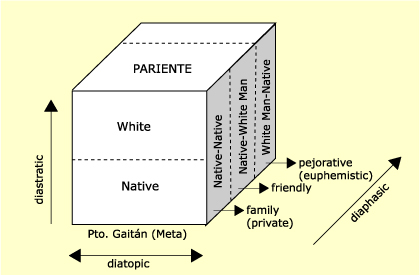
| Sociolingüística internacional |
Analysis of the term
‘pariente’ as a form |
||||
| CONTINUA |
|
One of the main traits of the
Sikuani society is their sense of family. From an early age, a child is taught a peculiar
form of relating to his parents, a relationship that supersedes the model of the white man
and drives him to establish a solid fraternal link with them. This relationship is based
on the concept of extended family, ‘penajipanabiwi’. They also share the
idea of nuclear family, ‘nacaemonae’, but do not share the concept of
individualism. The sense of group is very closely linked to the language, so a person,
distant relative, or even a person who is not family, can be part of the family if he
speaks the same language, if not, he is accepted under other circumstances. This way of
viewing the social world has perhaps fostered the adoption of a term like
‘pariente’, which is an intermediate term between ‘familiar’ and
‘amigo’.
Let’s not forget that the word ‘pariente’, in Latin parentem, lacked, at first, any trait of blood relationship that is now associated with it. Also, propinquus meant ‘vecino’, ‘cercano’, ‘allegado’ or ‘semejante’, as well as the traditional structure to which it was necessary to include in an explanatory manner, the formula for relationships: consanguinitate propinquus. In looking up the term ‘pariente’, the Breve diccionario de la lengua castellana by Guido Gómez (1988: 518-519) refers to the word ‘parir’ (from the Latin parere ‘parir’, ‘dar a luz’, ‘obtener’) and the word ‘parar’ (from the Latin parare of per- ‘otorgar’, ‘obtener’ de la misma familia: amparar) therefore the double meaning of the term ‘pariente’ is etymologically corroborated: i) from the same family in some degree of blood relationship and ii) friend or fellow man (semejante). This last definition coincides with the Sikuani’s idea of extended family and their idiomatic sense (same language = fellow man = ‘pariente’ - relative), means that the word, adopted from the white man, keeps a relevant trait that has a lot to do with the degree of resemblance among individuals. Even the world ‘familiar’ appears in the Diccionario de construcción y régimen including words that are different from the characteristics of blood relationship: "3. sust. m. a) Pariente próximo o amigo de alguien... b) Criado, sirviente... e) Cofrade, el que toma la insignia o hábito de una comunidad religiosa... Per. antecl. Siglo XV: X ‘Familiar cosa: familiaris, -e, Domesticus.’ Nebr. Vocab. X ‘Familia... y familiares a los de la mesma familia: Después también los seruentes se començaron llamar deste nombre familiares... Etim. Fr. familier, it. familiare, port. familiar. Del lat. familiaris, ‘familiar, amigo, sirviente’." (Tomo IV: 71-74). It is there that another direction of the term ‘familiar’ is described that, in my opinion, we consider is the basis of selection and present use of ‘pariente’ among the Sikuani: "c) Referido al genio que acompaña y dirige a la manera del demonio mitológico... d) Espíritu, demonio, ser sobrenatural que se suponía acompañaba a una persona para inspirarla y dirigirla y que se llevaba en un anillo o en otra alhaja doméstica. a ) X ‘!Sai acá, familiar que en ser diablo en cara y costumbres más pareces familiar de redoma o sortija!" (Tomo IV: 69 y 73). Among the people the term ‘familiar’ is a subtle way of referring to the devil, substituted by other burlesque terms like ‘el patas’, ‘el putas’ or ‘el pariente’ ("se lo llevó el pariente"). If we associate this diabolical idea with that of ‘semejanza’ referred to above, we can imagine that the image of this fearsome being is one of a male goat, a common figure in indigenous cultures and even in ‘civilized’ cultures. From a physical point of view, the ‘familiar’ or ‘pariente’ is very similar to man and animals. There is an obvious relationship between the two; consequently, one of informants responded that: "Pariente is a bad word. It sounds bad. It is said of an animal and person to make fun of them." With the intention of corroborating these opinions and finding new data, a series of surveys were taken (10 total) using the same informants that were used in the case of the pronominal forms of address. Using this data, we came up with a general diagram of the use of the word ‘pariente’ among the natives and white men, considering its diatopic, diastratic, and diaphasic variation (see Fig. 4). According to the corpus collected, we see that the forms of address follow a particular ‘polysemic dynamic’ just as C. Rossfelder and G. Maxime Lizoir had declared. This means that the term acquires different meanings depending upon the situation. Thus, the word ‘pariente’ has various connotations that depend on the speakers, time, disposition, subject, etc. Above all, I must say that ‘pariente’ is a word that is becoming obsolete. This is due to the process of acculturation and to the fact that each day it acquires the Spanish connotations of the colonist (blood relation) and moves away from the traditional Sikuani meaning that sought to reinforce the interethnic sense of ‘extended family’. In Puerto Gaitán there are still some signs of this past at a desolate meat roasting place called ‘El Pariente’ and at a bar where many Sikuani living in the area go called ‘Etnotaberna’. Figure 4. Diagram use of "pariente" expression in Puerto Gaitán (Meta) established between colonists and natives depending on diatopes, diastratics and diaphasics  |